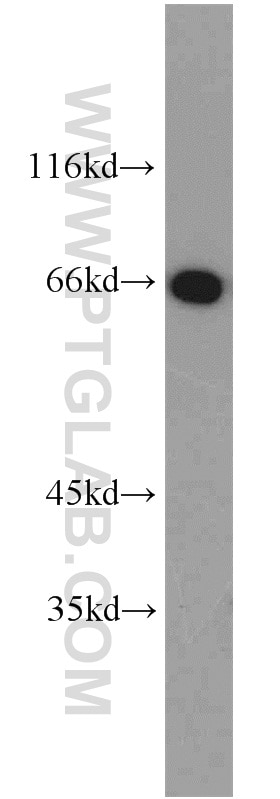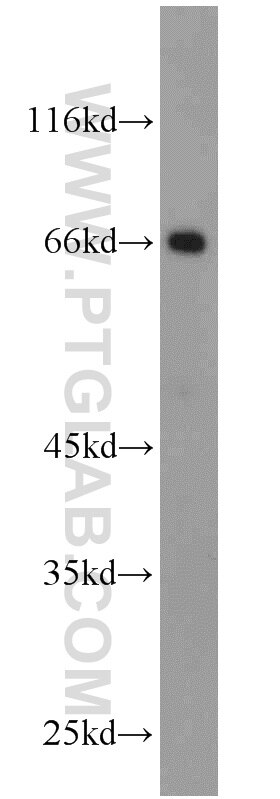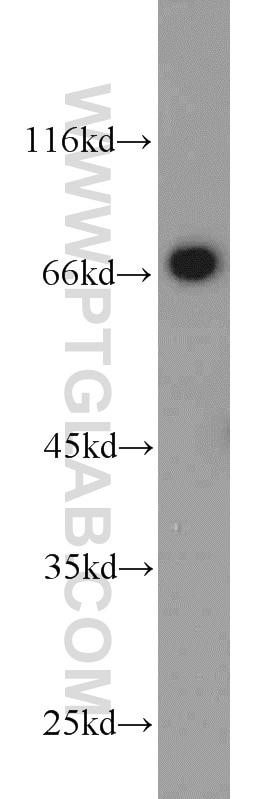Anticorps Polyclonal de lapin anti-HSF4
HSF4 Polyclonal Antibody for WB, IHC, ELISA
Hôte / Isotype
Lapin / IgG
Réactivité testée
Humain, rat, souris
Applications
WB, IHC, ELISA
Conjugaison
Non conjugué
N° de cat : 22883-1-AP
Synonymes
Galerie de données de validation
Applications testées
| Résultats positifs en WB | cellules HeLa, tissu cardiaque de souris, tissu cérébral de rat, tissu cérébral de souris, tissu cérébral humain, tissu de muscle squelettique de souris, tissu pulmonaire de souris |
| Résultats positifs en IHC | tissu cérébral de souris, il est suggéré de démasquer l'antigène avec un tampon de TE buffer pH 9.0; (*) À défaut, 'le démasquage de l'antigène peut être 'effectué avec un tampon citrate pH 6,0. |
Dilution recommandée
| Application | Dilution |
|---|---|
| Western Blot (WB) | WB : 1:1000-1:4000 |
| Immunohistochimie (IHC) | IHC : 1:50-1:500 |
| It is recommended that this reagent should be titrated in each testing system to obtain optimal results. | |
| Sample-dependent, check data in validation data gallery | |
Applications publiées
| WB | See 1 publications below |
Informations sur le produit
22883-1-AP cible HSF4 dans les applications de WB, IHC, ELISA et montre une réactivité avec des échantillons Humain, rat, souris
| Réactivité | Humain, rat, souris |
| Réactivité citée | Humain |
| Hôte / Isotype | Lapin / IgG |
| Clonalité | Polyclonal |
| Type | Anticorps |
| Immunogène | HSF4 Protéine recombinante Ag18935 |
| Nom complet | heat shock transcription factor 4 |
| Masse moléculaire calculée | 492 aa, 53 kDa |
| Poids moléculaire observé | 62-66 kDa |
| Numéro d’acquisition GenBank | BC153061 |
| Symbole du gène | HSF4 |
| Identification du gène (NCBI) | 3299 |
| Conjugaison | Non conjugué |
| Forme | Liquide |
| Méthode de purification | Purifié par affinité contre l'antigène |
| Tampon de stockage | PBS with 0.02% sodium azide and 50% glycerol |
| Conditions de stockage | Stocker à -20°C. Stable pendant un an après l'expédition. L'aliquotage n'est pas nécessaire pour le stockage à -20oC Les 20ul contiennent 0,1% de BSA. |
Informations générales
Prokaryotic and eukaryotic cells respond to thermal and chemical stress by inducing a group of genes collectively designated heat shock genes. In eukaryotes, this gene expression is regulated primarily at the transcriptionlevel. Heat shock transcription factors (HSF, also designated HSTF) 1 and 2 are involved in this regulation. HSF1 and HSF2 are upregulated by estrogen, at both the mRNA and protein level. HSF1 is normally found as a monomer, whose transcriptional activity is repressed by constitutive phosphorylation. Upon activation, HSF1 forms trimers, gains DNA binding activity and is translocated to the nucleus. HSF2 activity is associated with differentiation and development, and, like HSF1, binds DNA as a trimer. HSF4 exists as two splice variants and is expressed in heart, brain and skeletal muscle as a homotrimer. HSF4a does not contain a DNA-binding domain and inhibits the formation of HSF1 nuclear bodies, thus repressing HSF1 mediated transcription. HSF4b does contain a DNA-binding domain and colocalizes with HSF1 nuclear bodies after heat shock. This antibody is specific to human HSF4.
Protocole
| Product Specific Protocols | |
|---|---|
| WB protocol for HSF4 antibody 22883-1-AP | Download protocol |
| IHC protocol for HSF4 antibody 22883-1-AP | Download protocol |
| Standard Protocols | |
|---|---|
| Click here to view our Standard Protocols |









